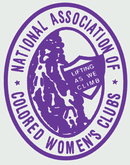- National Association of Colored Women
-
The National Association of Colored Women Clubs (NACWC) was established in Washington, D.C., USA, by the merger in 1896 of the National Federation of Afro-American Women, the Women's Era Club of Boston, and the National League of Colored Women of Washington, DC, as well as smaller organizations that had arisen from the African-American women's club movement.
Founders of the NACWC included Harriet Tubman, Margaret Murray Washington,[1] Frances E.W. Harper, Ida Bell Wells-Barnett, and Mary Church Terrell. Its two leading members were Josephine Ruffin and Mary Church Terrell. Their original intention was "to furnish evidence of the moral, mental and material progress made by people of color through the efforts of our women". The NACW came about as a result of a letter written by James Jacks, the president of the Missouri Press Association, challenging the respectability of African American women, referring to them as thieves and prostitutes.[2]
During the next ten years, the NACW became involved in campaigns in favor of women's suffrage and against lynching and Jim Crow laws. They also led efforts to improve education, and care for both children and the elderly. By 1918, when the United States entered the First World War, membership in the NACW had grown to an extraordinary 300,000 nationwide.
The National Association of Colored Women was the most prominent organization formed during the Black Women’s Movement. This was due chiefly to the efforts of Josephine St. Pierre Ruffin and Mary Church Terrell. Both women were educated, had economically successful parents, and were of mixed racial background.
Born on August 31, 1842 in Boston, Josephine St. Pierre was the daughter of John St. Pierre, a successful clothes dealer from Martinique. Little is known about her mother. Her parents supported her going to school in Salem for integrated schools, rather than Boston. There Josephine St. Pierre flourished. At age 16 she married George Lewis Ruffin, the first African-American graduate of Harvard Law School. Among their early activities was recruiting black soldiers for the Union Army during the Civil War.
After George Ruffin died in 1886, Josephine St. Pierre Ruffin used part of her estate to fund Woman’s Era, the first journal published by and for African-American women. Ruffin was a vice-president of the National Association of Colored Women. In 1910 Ruffin enlarged her social activism by helping form the National Association for the Advancement of Colored People (NAACP). She died in March 1924.
Mary Church Terrell was the daughter of Charles Church, a former slave and reputed son of a white master. Charles Church built a business and became one of the wealthiest black men in the South. He was able to send Mary to Oberlin College, where she earned both bachelor's and master's degrees. Years later Mary Church Terrell spoke at the Berlin International Congress of Women. She made a great impression because she gave her speech in fluent German and French, as well as English. Terrell was the only black woman at the conference.
Terrell became president of the National Association of Colored Women in the United States. She led the struggle in Washington, DC against segregation in public eating places and succeeded in winning a court decision for integration there. Mary Church Terrell died in Annapolis, Maryland on 24 July 1954.
The organization of the National Association of Colored Women helped all African-American women by working on issues of civil rights and injustice, such as women’s suffrage, lynching, and Jim Crow laws.
Contents
NACW Objectives:
- To work for the economic, moral, religious and social welfare of women and youth.
- To protect the rights of women and youth.
- To raise the standard and quality of life in home and family.
- To secure and use our influence for the enforcement of civil and political rights for African Americans and all citizens.
- To promote the education of women and youth through the work of the departments.
- To obtain for African American women the opportunity of reaching the highest levels in all fields of human endeavor.
- To promote effective interaction with the male auxiliary.
- To promote inter-racial understanding so that justice and good will may prevail among all people.
- To hold educational workshops biennially at the Convention.
Presidents
- Mary Church Terrell — 1st President (1896–1900)
- Josephine Silone Yates — 2nd President (1900–1904)
- Lucy Thurman — 3rd President (1904–1908)
- Elizabeth Carter Brooks — 4th President (1908–1912)
- Margaret James Murray (Mrs. Booker T. Washington) - 5th President (1912–1916)
- Mary B. Talbert — 6th President (1916–1920)
- Miss Hallie Q. Brown -7th President (1920–1924)
- Mary McLeod Bethune — 8th President (1924–1928)
- Mrs. Sallie Wyatt Stewart - 9th President (1928–1933)
- Dr. Mary F. Waring, 10th President (1933–1937)
- Mrs. Robert Moton, 11th President (1937–1941)
- Mrs. Ada Belle Dement, 12th President (1941–1945)
- Mrs. Christine S. Smith 13th President (1945–1948)
- Dr. Ella P. Stewart 14th President (1948–1952)
- Irene McCoy Gaines 15th President (1952–1958)
- Dr Rosa L. Gragg 16th President (1958–1964)
- Mamie B. Reese 17th President (1964–1968)
- Myrtle Ollison 18th President (1968–1972)
- Juanita W. Brown — 19th President (1972–1976)
- Inez W. Tinsley -20th President (1976–1980)
- Otelia Champion -21st President (1980–1984)
- Myrtle E. Gray -22nd President (1984–1988)
- Dolores M. Harris 23rd President (1988–1992)
- Savannah C. Jones — 24th President (1992–1996)
- Patricia L. Fletcher — 25th President (1996–2002)
- Margaret J. Cooper — 26th President (2002–2006)
- Dr. Marie Wright Tolliver - 27th President (2006–2010)
- Evelyn Rising - 28th President (2010-current)
See also
- African-American Woman Suffrage Movement
- Black Feminism
References
- ^ http://english.illinoisstate.edu/kalmbach/351/hypertext98/hankins/african/Washington.html
- ^ http://books.google.com/books?id=v6-fS190xuIC&dq=white+too+heavy+a+load&printsec=frontcover&source=bn&hl=en&ei=aZApS6-NIM-LlAfNga2jBw&sa=X&oi=book_result&ct=result&resnum=4&ved=0CBsQ6AEwAw#v=onepage&q=jacks&f=false
External links
Categories:- African American history
- Dupont Circle
- Organizations based in Washington, D.C.
- Women's clubs in the United States
- African American women's organizations
Wikimedia Foundation. 2010.


